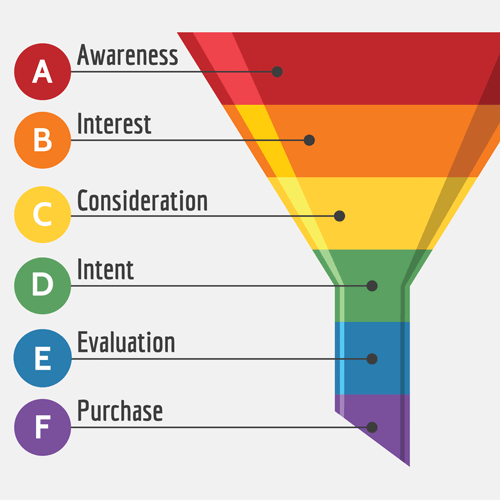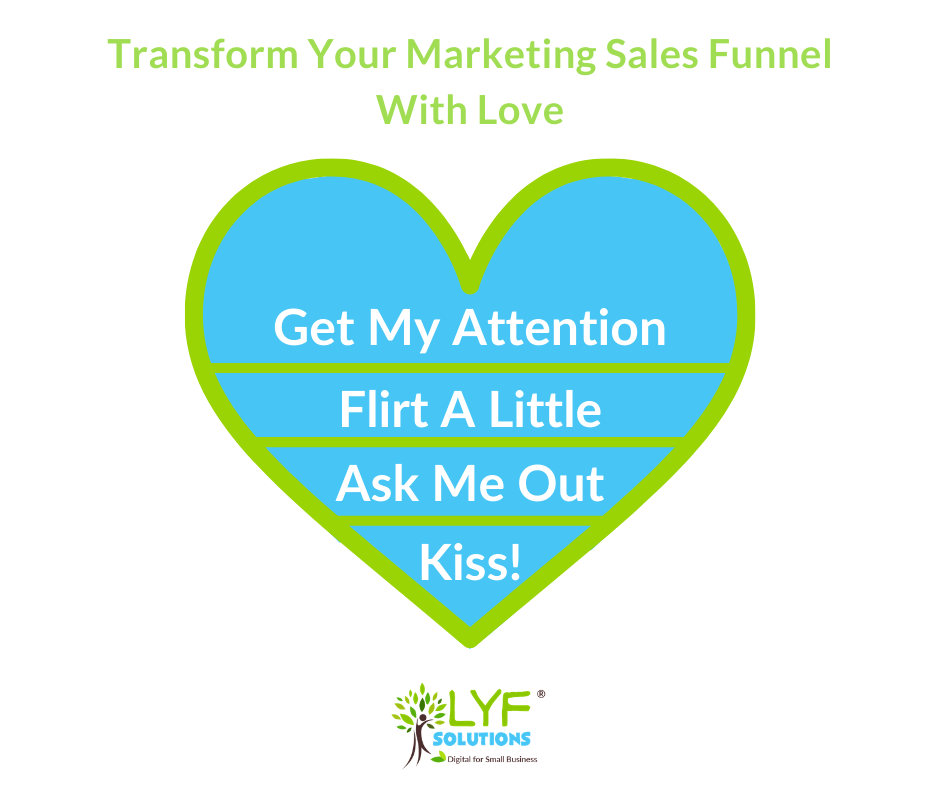If you’ve done even the most basic research about marketing, you’re no doubt familiar with the marketing sales funnel. It’s a marketing concept that has been around for years, and is often cited by marketing gurus as the only way to effectively market your business.
But what if we told you that there’s another way to market your business, and that it’s not as rigid as you were led to believe?
We’d like to introduce you to a fresh way of approaching your business marketing. It’s an approach that puts your customers first, and can result in deeper and more meaningful relationships that turn customers into a committed and engaged community that is loyal to your brand!
Read on to find out more about how love can transform your marketing sales funnel, and the steps you can take to put this method into practice.

What is a marketing sales funnel?
Let’s begin by briefly exploring the traditional marketing sales funnel. This is one you’ll see in various books and websites, and hasn’t really changed much in that time. This is despite the fact that marketing channels and audience expectations have definitely changed!
So what is a sales funnel in digital marketing? Take a look at this graphic:

When it comes to turning leads into sales, this traditional marketing sales funnel is often cited as the simplest way to do it. The thing is, it reduces people – your potential customers – into dollar signs. The thing is, people have more value to your business than what’s in their pocket.
When you’re focused on simply making a sale, you’re missing some important opportunities that can help grow your customer base and your business in the long run.
We’re all about helping small businesses grow, so we want to help you see that this traditional, rigid sales funnel of the past is just not as effective as it’s touted to be, particularly for small businesses.
The future of digital marketing sales funnel is all about love. We want you to consider a relationship building marketing approach that will lead to organic, sustainable, long-term growth for your business with a focus on sparking engagement and continuous sales from your customers!

Adding the love component in your marketing sales funnel
This new approach to the sales funnel marketing strategy is perfect if you want to learn:
- How to attract more customers to your small business
- How to grow your small business website traffic
- How to increase leads for your small business through marketing
If we had to boil down this approach into a few words, we’d say it’s all about building customer relationships through effective marketing.
The traditional sales funnel marketing strategy completely leaves the customer’s motivations, thoughts, and emotions out of the equation. You can see how this can be unsustainable in the long run.
Adding the love component in your digital marketing sales funnel is just like falling in love with your soulmate – it’s not about talking at them and then expecting heartfelt love in return, it’s about building a strong relationship over time, by getting to know them and understanding what’s important to them. That’s what building customer relationships in marketing is all about!
Approaching your sales and marketing with love, care, and affection for your customers works particularly well for small businesses. More than anything, though, it’s actually much easier to use this approach effectively when you’re a small team (or a solo entrepreneur) instead of a large corporation.
Since this marketing method is all about interaction and building relationships, it is so much easier for a small business to manage the day-to-day activities required to create genuine relationships with a customer base.
We’ve seen so many small businesses do this in a way that is authentic and cohesive across all marketing channels, and it’s something that we’re committed to as well, so read on to find out exactly how to add the love component to your marketing to help your business grow.
Creating a sales funnel based on love and relationships
Since we’re putting relationships at the centre of this new marketing sales funnel approach, this useful heart-shaped graphic is a great way to express the ideas we’ll be introducing to you! We want you to start approaching your sales marketing from a place of love, trust, and authenticity. Here are the steps you can take to get there:

1. Get my attention
Just like that initial spark of attraction when you meet someone you’re romantically interested in, you need to showcase your brand in the best light to pique your customers’ interest. This is the first step of building a relationship with your customers, where they get to know you a little better and decide if you’re worth their time.
This step is where you focus on content and activities that create brand awareness and introduces your business’ core values.
Here are examples of the things you can do at this stage:
- Craft a clear and compelling About page that fully outlines the key values of your brand.
- Prioritise user experience (UX) in your website design, with a focus on easy navigation, accessibility, as well as cohesive and memorable branding.
- Share content on social media that accurately represents your brand and the people behind it.
- Sell the lifestyle, not the product or service. Always highlight how your customers’ lives will be improved or how their problems will be solved, instead of just listing key benefits of what you’re trying to sell.
- Offer high value content to your customers for free. Examples include eBooks, guides, research statistics, and comprehensive blog posts.
- Introduce yourself in different ways. This means you need to show up on different marketing channels and remind audiences who you are. For example, you can share some “get to know us” posts on social media every week, or automatically send off a quick introduction email anytime someone signs up to your newsletter.
- Be authentic in all your marketing communications – don’t try to be someone you’re not! You want customers to love you for who you are, not someone you think they’d like to see.
2. Flirt a little
At this stage of your sales marketing process, you’re trying to make yourself more memorable to your customers. This is easier said than done, as audiences are inundated with content 24/7! So you need to figure out what makes you special.
What sets you apart from your competitors? What features are unique to your product or brand? Is there something in the story of your brand that makes you different from the rest? Once you nail down what makes your business unique, you need to highlight that in all your marketing and interactions.
However, just like you wouldn’t just flirt with any random stranger on the street (or at the very least, you shouldn’t expect to get an enthusiastic response in return!), you need to get to know your love interest – your customer – a little bit too.
This is your chance to find out what makes them tick. What are your customers’ motivations? What makes them happy, sad, or angry? What are their dreams, ambitions, and aspirations? What type of content makes them stop the scroll and engage with your brand?
At this stage, there will be a lot of back and forth. There will be a lot of communication which will clue you in on how your customers feel about certain things. This information can then be factored into future interactions, and inform the next steps of your sales marketing funnel too.
Here are a few ideas on how you can put this approach into action:
- Make sure your branding is clear and consistent throughout all of your marketing!
- Highlight your core values in all your content marketing so you’re telling a cohesive story about your brand.
- Make sure your messaging and brand voice is consistent in every interaction with your audience, whether publicly or privately.
- Directly engage with your customers on social media. That means replying to comments, engaging with their content, and also responding to every message you receive.
- Show your audience some love and appreciation. For example, you can share user-generated content on your digital channels, including before and after photos, or product reviews.
- Ask the right questions. Create surveys or polls to get to know your audience better.
- Allow the audience to ask you some questions too! For example, you can host a Q&A session on Instagram Stories or Facebook Live.
- Don’t be a robot! Stay casual, informal, and approachable in your interactions with your audience. Make sure you’re responding like an actual person in all your interactions, and your audience will treat you as such.
3. Ask them out
In a romantic relationship, this step is often fraught with self-doubt and nerves. It’s the make or break moment – will this relationship have a chance at a happy ending, or will it not go past even the first few pages?
By this stage of your marketing sales funnel, you’re ready to see if your target audience wants in on what you’re selling. At this point, they’ve warmed up to you enough for you to comfortably call them potential customers.
So how do you turn potential customers into paying customers? Well, the first thing to understand that it’s not going to happen with each and every relationship you’ve sparked. So manage your expectations. However, just because you couldn’t make a sale this time, doesn’t mean it’s out of the question next time.
Just make sure you truly understand what stopped them from becoming a customer this time around, and try and remove that obstacle in the future. But please, do not pester them about it! According to a recent IAB study, almost 30% of Australian consumers use ad blockers. The more we annoy audiences, the less we have to target to, so be mindful of this.
Secondly, you have to make sure that your website or other sales channels are ready to handle the sales that are about to happen. Nothing’s worse than getting your audience so close to the finish line, only to realise that technology kept them from completing a purchase!
Here are a few ways you can turn your leads into potential sales:
- Create a special offer just for your most engaged followers. These are the folks that comment on your posts, have conversations with you via direct messages, and have made it clear that they’re into your brand.
- Share product recommendations where appropriate. A great way to do this organically is by identifying the problems your audience is facing, and recommending a product that can help them with the issue.
- Use social proof to your advantage. Make sure to share customer testimonials and reviews whenever you’re promoting a product or service.
- Always personalise your product or service offer whenever possible. For example, you should use a customer’s first name in all your email direct marketing.
4. Get the first kiss
So you got the date. If you were really good at the first three stages, then you’ve got the first kiss (i.e, made the sale) already! However, not all of us are lucky enough to get a kiss on the first date. So how can you score that smooch now?
Let’s imagine the customer is on your website, ready to buy something for you. Is there anything on the site that could have discouraged them from finalising their purchase? Alternatively, was there something more you could have done in the first three stages to have helped them along their way?
In this step, you’ll likely have to flirt a little more or ask them out on yet another date. This may go on and on several times before you get a sale. However, it’s important not to be discouraged! If anything, the gift of additional time to get to know each other can be priceless in building a long-term relationship eventually. It can go a long way in creating returning customers who are loyal to your brand.
Here’s how you can continue remarketing to your audience to eventually make that sale:
- Send a message or advertising to those who responded well to your previous communications or posts.
- Remind customers via email or advertising that they have items in their shopping cart that they might have forgotten to check out.
- Always reward loyalty. This can be as simple as giving customers a discount code for their next purchase with you, or creating a loyalty program or affiliate marketing program.

Marketing Sales Funnel Metrics
No matter how you approach your digital marketing – whether it’s a traditional sales funnel or a marketing sales funnel based on relationships – it’s absolutely vital that you identify the key metrics to analyse and measure.
Your marketing funnel analytics can be split between these three groups:
- Interaction metrics, which refer to how your leads respond and engage with your content. This can include visits to your website or unsubscription rates from your emails.
- Performance metrics, which evaluates how effective your funnel generally is. This can include the amount of qualified leads, or sales opportunities.
- ROI (return on investment) metrics, which assesses how much value for money your efforts have been. This may include factors such as the cost of customer acquisition and total income generated.
Now, you could spend hours upon hours monitoring every single metric, or you can save yourself some time by monitoring just these five most important ones.
1. Cost Per Acquisition (CPA)
This is one of the most important metrics you need to monitor, as it provides you with a clear insight to how much ROI you’re getting through your marketing sales funnel. In a nutshell, this metric defines the cost of acquiring a single customer that makes a purchase through a specific campaign, essentially the cost for that sale.
CPA can be calculated by dividing the cost of customer acquisition (the cost of your marketing sales funnel) by the number of customers you acquired in the same time period.
How to calculate CPA
Cost Per Acquisition = (Total Customer Acquisition Cost / Total new customers acquired)
2. Customer Lifetime Value (CLV)
The CLV is used to project the income that a single customer will generate throughout their interactions with your business in their lifetime. It is essentially the average profit from all your customers. It’s all about calculating the lifetime value of the leads you’ve generated using your marketing sales funnel.
You can calculate the CLV by taking into account the average income from each customer, the number of annual sales from that customer, and the average annual profit margins. Then, you’ll need to use this yearly profit margin and the customer retention rate to calculate the CLV for each customer that is going through your marketing sales funnel.
How to calculate CLV
Average purchase x Number of purchases per year x Average profit margin % = Yearly profit margin average per customer
Customer Lifetime Value = Yearly profit margin average per customer x (Customer retention rate / 1 + Rate of discount – Customer retention rate)
3. Conversion rate of each stage of the funnel
The whole point of your marketing sales funnel is to generate qualified leads to your business. These potential customers will be coming your way throughout the various stages of the marketing funnel, via different channels.
You need to frequently assess how each stage of your relationship-based marketing sales funnel is performing. This will help you identify any stages that need improvement, and allow your funnel to attract high quality leads that are more likely to make a purchase from you.
4. Conversion rate per channel
When it comes to your marketing sales funnel, it’s so important to not put all your eggs in one basket. Using diverse channels will allow you to reach more audiences and drive more traffic to your site. But not every channel is created equal. Each channel you use – whether it’s social media, email marketing, video marketing, or advertising – has its own ROI and conversion rate.
You have to analyse the conversion rates for each channel so you’re not wasting resources by investing in channels that just are not performing well for your business.
5. Duration of marketing cycle
You need to determine how long it takes for your leads to actually go through your marketing sales channel before a sale takes place. This can obviously vary depending on various factors, including the channels you’re using and quality of the landing pages that you’ve developed.
For this metric, the main objective should be to reduce the total amount of time that a lead spends in your funnel. The quicker you convert leads, the more revenue you’ll be able to make. You can assess this metric by tracking the time it takes for a qualified lead to make a sale.
Put people and relationships first
The key to any good marketing activity is to understand you’re dealing with real people. It takes two to tango. Relationships can take time. Building them at the different stages is your key to success, along with managing them in the future.
Need help creating a marketing strategy for your small business? At LYF Solutions, we are committed to helping small businesses grow in a sustainable way. Get in touch with us to find out how we can help you craft an effective marketing strategy for your target audience!















